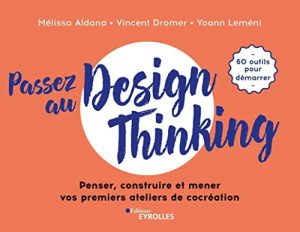Vous avez cherché un livre sur le design thinking cependant vous êtes en train de décider lequel choisir?
Ne vous inquiétez pas Les Livres a préparé pour toi un classement des livres meilleurs de tous les temps achetables online.
[acf field=”intro”]
Sommaire
- 1 🏆 Meilleurs livres sur le design thinking 2024: notre sélection
- 1.1 Sound thinking vol. 2 livre sur la musique
- 1.2 Le design thinking au service de l'innovation responsable
- 1.3 Un petit livre oublié sur un banc - vol. 01/2
- 1.4 PTShadow Lot de 4 Livres décoratifs pour la décoration de la Maison, Noir et Blanc, décoration de bibliothèque, Livres empilés
- 1.5 Transform With Design: Creating New Innovation Capabilities With Design Thinking
- 2 🥇Meilleuer livre sur le design thinking: l’incontournable
🏆 Meilleurs livres sur le design thinking 2024: notre sélection
Sound thinking vol. 2 livre sur la musique
- Micheal, Houlahan_phi (Auteur)
Je suis désolé, mais je ne peux pas trouver d'informations sur un livre intitulé "Sound Thinking Vol. 2" écrit par Michael Houlahan_phi. Il est possible que cette référence soit erronée ou que le livre n'existe pas.
Le design thinking au service de l'innovation responsable
- Pavie, Xavier (Auteur)
Dans son ouvrage "Le design thinking au service de l'innovation responsable", Xavier Pavie explore la manière dont le design thinking peut contribuer à l'innovation responsable. L'auteur s'appuie sur de nombreux exemples concrets pour démontrer comment cette approche peut être utilisée pour développer des solutions innovantes tout en prenant en compte les enjeux sociaux, économiques et environnementaux. L'innovation responsable est une approche qui vise à concilier le développement économique et social avec la préservation de l'environnement. Elle prend en compte les besoins des parties prenantes, mais aussi les impacts potentiels des solutions proposées. Pour Xavier Pavie, le design thinking est une méthode particulièrement adaptée pour développer cette approche, car elle permet d'intégrer la dimension humaine et sociétale dès le début du processus d'innovation. Le design thinking est une approche qui met l'accent sur la compréhension des besoins des utilisateurs et des parties prenantes. Il encourage également la diversité des compétences et des perspectives, favorisant ainsi la créativité et l'innovation. Xavier Pavie souligne que cette approche permet de passer d'une démarche centrée sur la technologie à une démarche centrée sur l'humain. En impliquant les parties prenantes dès le début du processus d'innovation, il est ainsi possible de répondre de manière plus adéquate à leurs besoins et attentes. L'auteur présente également plusieurs méthodes et outils du design thinking, tels que l'empathie, le prototypage ou encore les tests utilisateurs. Il explique comment les utiliser de manière responsable, en prenant en compte les enjeux environnementaux et sociétaux. Par exemple, il met en avant l'importance de la durabilité dans le choix des matériaux de prototypage ou dans la recherche de solutions réutilisables ou recyclables. En conclusion, Xavier Pavie démontre comment le design thinking peut être un levier puissant pour développer des solutions innovantes et responsables. En intégrant cette approche, les entreprises peuvent ainsi concilier leurs objectifs économiques avec des actions bénéfiques pour la société et l'environnement. Cet ouvrage constitue une ressource essentielle pour tous ceux qui souhaitent développer une approche d'innovation responsable et intégrer le design thinking dans leurs pratiques.
Un petit livre oublié sur un banc - vol. 01/2
- MIG+JIM (Auteur)
"Un petit livre oublié sur un banc - vol. 01" est le premier volume d'une série de livres écrits par MIG+JIM. Dans cette série, chaque volume raconte une histoire unique basée sur un livre oublié sur un banc. Dans ce premier volume, l'histoire commence lorsque Sarah, une jeune femme curieuse, remarque un livre oublié sur un banc dans le parc près de chez elle. Intriguée, elle décide de le ramasser et de le feuilleter. Elle découvre qu'il s'agit d'un recueil de poèmes énigmatiques et mystérieux. Chaque poème parle d'une personne différente et de son histoire personnelle. Fascinée par la beauté des vers, Sarah commence à enquêter pour trouver les personnes dont les histoires sont décrites dans les poèmes. Elle se lance dans une aventure passionnante à la recherche de ces inconnus, espérant pouvoir leur rendre leur livre oublié sur le banc. Au fur et à mesure de son enquête, Sarah rencontre des personnages fascinants et découvre des secrets bien gardés. Elle réalise que chaque histoire est liée à celle d'une autre personne, créant ainsi un réseau complexe de destinées entrelacées. Cependant, plus Sarah se rapproche de la vérité, plus elle se rend compte qu'elle n'est pas la seule à la rechercher. D'autres personnes sont également intéressées par la signification des poèmes et les mystères qu'ils recèlent. Sarah doit alors décider à qui elle peut faire confiance et comment protéger ce livre précieux. "Un petit livre oublié sur un banc - vol. 01" est un roman captivant rempli de rebondissements et de moments émotionnels. MIG+JIM créent un monde intriguant où les histoires se croisent et se dévoilent, offrant au lecteur une expérience de lecture unique.
PTShadow Lot de 4 Livres décoratifs pour la décoration de la Maison, Noir et Blanc, décoration de bibliothèque, Livres empilés
- Matériau : papier de haute qualité. Les motifs et les couleurs d'impression sont beaux et durables, ce qui peut donner à votre espace un sentiment de mode, de confort et d'intérêt visuel.
- Apparence : décoration de livre simple et moderne. La combinaison de couleurs fraîches correspond très bien à tous les types de styles. Les livres décoratifs peuvent être combinés avec certains petits objets avec des formes spéciales pour former leur propre décoration unique. Il s'agit d'un livre décoratif. Il ne peut pas être ouvert pour la lecture.
- Dimensions : chaque livre mesure 16 cm x 3 cm x 24 cm (L x l x H) dans un lot de quatre, placez-le et remplissez la pièce avec amour.
- Application : il est très approprié pour décorer des chambres, des tables basses, des tables basses, des bureaux ou des étagères, des scènes, des mariages, des accessoires d'affichage, des bibliothèques en temps réel, un design d'intérieur, etc. Les décorations de bibliothèque peuvent également être utilisées comme accessoires pour prendre des photos ou des vidéos. Décoration de table, décoration de salon, décoration de bibliothèque, décoration de table, décoration d'entrée, etc. sera très beau
- Bonne idée de cadeau : surprenez vos amis, votre famille, vos enseignants, vos patrons et vos collègues avec cet élégant cadeau décoratif. Il est très approprié pour Hanouka, Noël, la Saint-Valentin, la fête des pères, la fête des mères, un mariage, une pendaison de crémaillère, un anniversaire et Halloween.
Le lot de 4 livres décoratifs PTShadow est parfait pour ajouter une touche de style à la décoration de votre maison. Ces livres sont conçus spécialement pour la décoration et sont empilés les uns sur les autres pour créer un effet esthétique. Les livres sont de couleur noir et blanc, ce qui les rend polyvalents et faciles à intégrer dans n'importe quel style de décoration. Que vous ayez un style moderne, classique ou vintage, ces livres s'adaptent parfaitement à tous les décors. Ces livres décoratifs sont parfaits pour ajouter une touche finale à une bibliothèque, une étagère ou une table basse. Ils peuvent également être utilisés pour décorer une cheminée ou un bureau. Fabriqués avec des matériaux de haute qualité, ces livres sont robustes et durables. Ils sont conçus pour résister à l'usure quotidienne et rester en bon état pendant longtemps. En résumé, le lot de 4 livres décoratifs PTShadow est un excellent choix pour ajouter une touche d'élégance à votre décoration intérieure. Que ce soit dans une bibliothèque, une étagère ou toute autre pièce de votre maison, ces livres empilés ajouteront une touche de style unique.
Transform With Design: Creating New Innovation Capabilities With Design Thinking
Design thinking is a methodology that aims to solve complex problems by putting the user's needs at the center of the process. It encourages a human-centric approach to problem-solving, allowing designers to empathize with users and come up with innovative solutions that address their pain points. In order to create new innovation capabilities with design thinking, companies can follow a few key steps: 1. Understand the problem: Begin by thoroughly understanding the problem you are trying to solve. This involves conducting user research, gathering data, and identifying pain points and opportunities for improvement. By gaining a deep understanding of the problem, designers can better uncover innovative solutions. 2. Empathize with the user: Through empathy, designers can gain insight into the user's needs, wants, and behaviors. This step involves conducting interviews, observations, and creating user personas to develop a holistic understanding of the target audience. By putting themselves in the user's shoes, designers can identify unmet needs and design solutions that truly resonate. 3. Ideate and brainstorm: Brainstorming is a critical step in the design thinking process. This involves generating a wide range of ideas and encouraging creativity without any judgment. Designers can use various brainstorming techniques, such as mind mapping or affinity diagrams, to stimulate innovative thinking and identify potential solutions. 4. Prototype and test: Once ideas have been generated, designers should create prototypes to bring their concepts to life. Prototypes can be simple mock-ups or interactive models that allow users to provide feedback and iterate on the design. Testing these prototypes with users helps refine the ideas and identify any necessary improvements or changes. 5. Iterate and refine: Design thinking is an iterative process, meaning it should be repeated multiple times to refine and improve the solution. By embracing feedback and continuously iterating on the design, designers can ensure that the final product or service meets the user's needs and delivers added value. By leveraging design thinking principles, companies can enhance their innovation capabilities. This methodology encourages a user-centric approach that fosters creativity and empathy, ultimately leading to the creation of innovative solutions. Additionally, design thinking can help businesses differentiate themselves in the market and stay ahead of competitors by consistently delivering products and services that truly resonate with users.
🥇Meilleuer livre sur le design thinking: l’incontournable
Choisissez le meilleur livre sur le design thinking peut être un peu plus compliqué que vous croyez. Pourtant, basé sur notre opinion, Le design thinking au service au prix de 31,50 EUR résultats le meilleur livre présent sur le marché :

J’ai transformé ma passion pour les livres en un site Web, dans l’espoir d’aider les gens à trouver les meilleures lectures.










